Key Types of List Segmentation Nonprofits Can Use for Basic Email Campaigns
1. How list segmentation can help nonprofits increase donations
2. List segmentation types for basic email campaigns of nonprofits
Useful tools:
1. Newoldstamp - Email signature marketing
2. Mailstrom - Tool for cleaning your inbox
3. Reply.io - Personal email outreach, calls, and tasks
4. Mailtrack - Email link opens tracking
5. Shift - Desktop app for streamlining all of your email and app accounts.
If your nonprofit aspires to be more sophisticated in its email marketing efforts, do not underestimate the power of list segmentation. According to MailChimp, the reputable email marketing platform, an email a person sends to interested groups of subscribers receives a 73% higher click rate than non-segmented campaigns, and around 10% higher open rate.
How list segmentation can help nonprofits increase donations
As an organization dealing with many people, you need to understand that no human is like another. They do not all want to interact with you in the same way. Each of your subscribers is unique, so you must treat them as such. Some of your contacts are active volunteers, while others prefer to donate; some want to attend events, while others want only to read about them in your eNewsletters. So if your goal is to grab their attention or, even better, get feedback, remember that it is almost impossible if you practice impersonal mass communication.
List segmentation types for basic email campaigns of nonprofits
Since not everyone who signs up for your updates is looking for the same information, you should segment your subscribers into different groups.
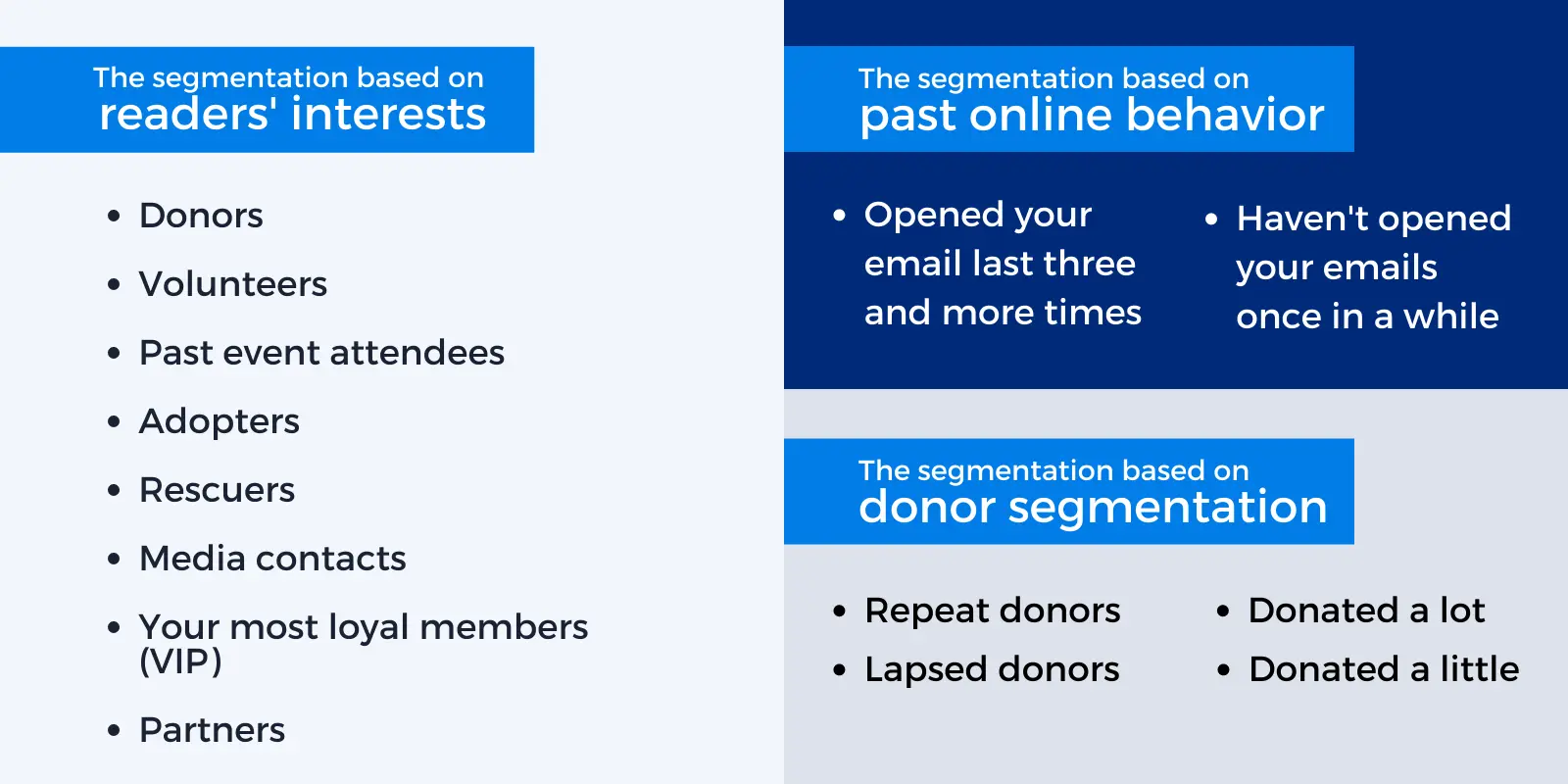
Your next step is to determine how and when you want to communicate with each group of people. The key to a successful email campaign is to create different letters that you will send to your database.
For example, let's take a group of past event attendees or volunteers. You can send them updates on new opportunities. Or you can even segment them based on their location. For example, if you take a group of those who haven't opened your emails in a while, you can remind them why they signed up for your newsletter in the first place.
Welcome email. The key purpose of welcome emails
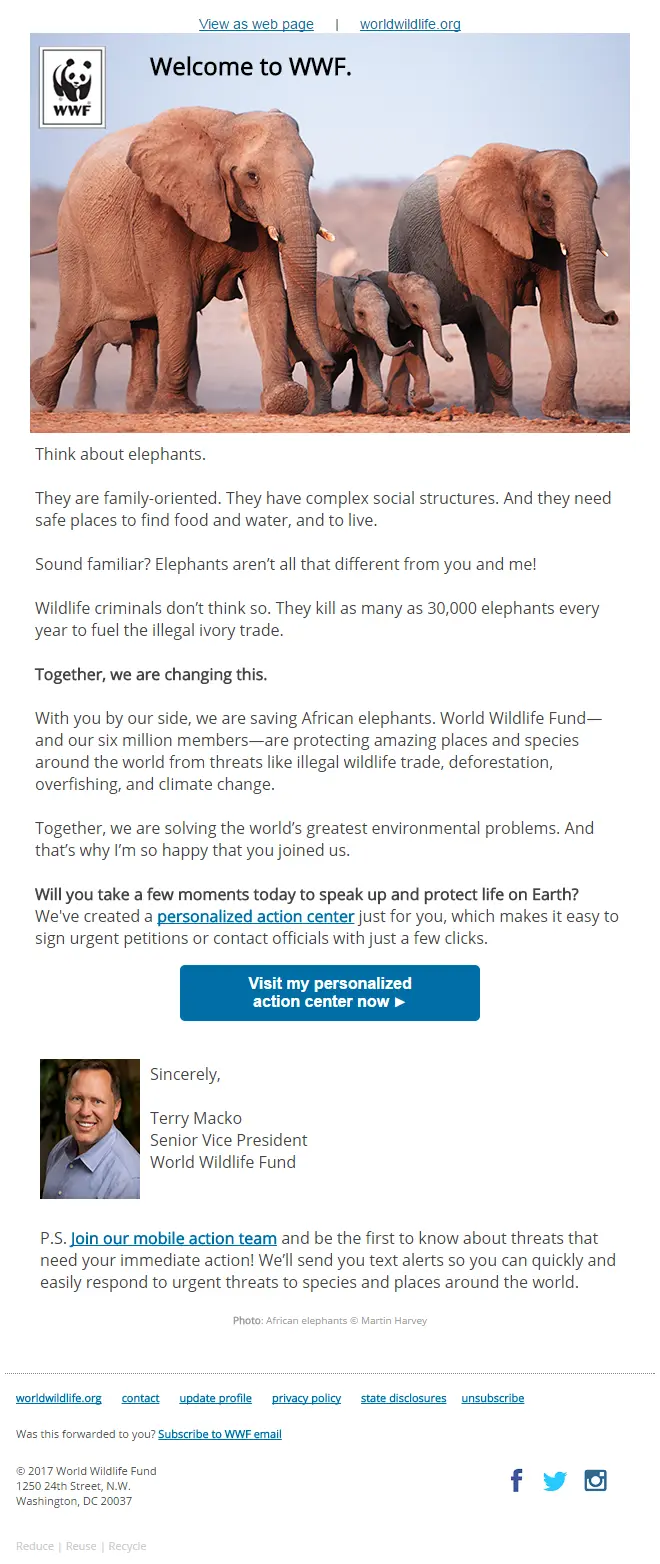
source: Copper
A welcome email is there to help your subscribers understand what your organization is all about, what you have to offer, and what they can do for you. Many organizations choose to send three to five preset emails instead of only one welcome email. What do they write? The first email should be just an introduction. It is personal and concise. The next one may present the goals of your organization (you can embed a video, tell your story, tell a story of a person who is personally affected by your organization, provide links to the most popular content on your website, etc.) Including a professional email signature in each email can reinforce your organization’s branding and ensure subscribers have your contact details readily accessible.

-
Public supporters
You need to concentrate on providing a general overview of your organization and its goals in a welcome email to people who can support you in any way. Explain to them how they can get involved (attend events and demonstrations, share your posts on social networks, and so on).
-
Sponsors
Provide a comprehensive description of your organization and your mission. Explain how businesses can help you through sponsorship opportunities.
-
Partners
Like the email to your sponsors, this letter should include information about lasting sponsorship and opportunities for cooperation about which businesses and other nonprofits can find out more.
-
Donors
Because these people already supported you, this email should express gratitude and appreciation, inform and inspire them. You may want to include a soft ask to follow you on Facebook or read your blog.
-
Volunteers
Volunteers who feel like a part of your family are more likely to stay with you and help you further. Make them feel loved and appreciated with a warm welcome email.
Charity event invitation. The key purpose of a charity invitation email
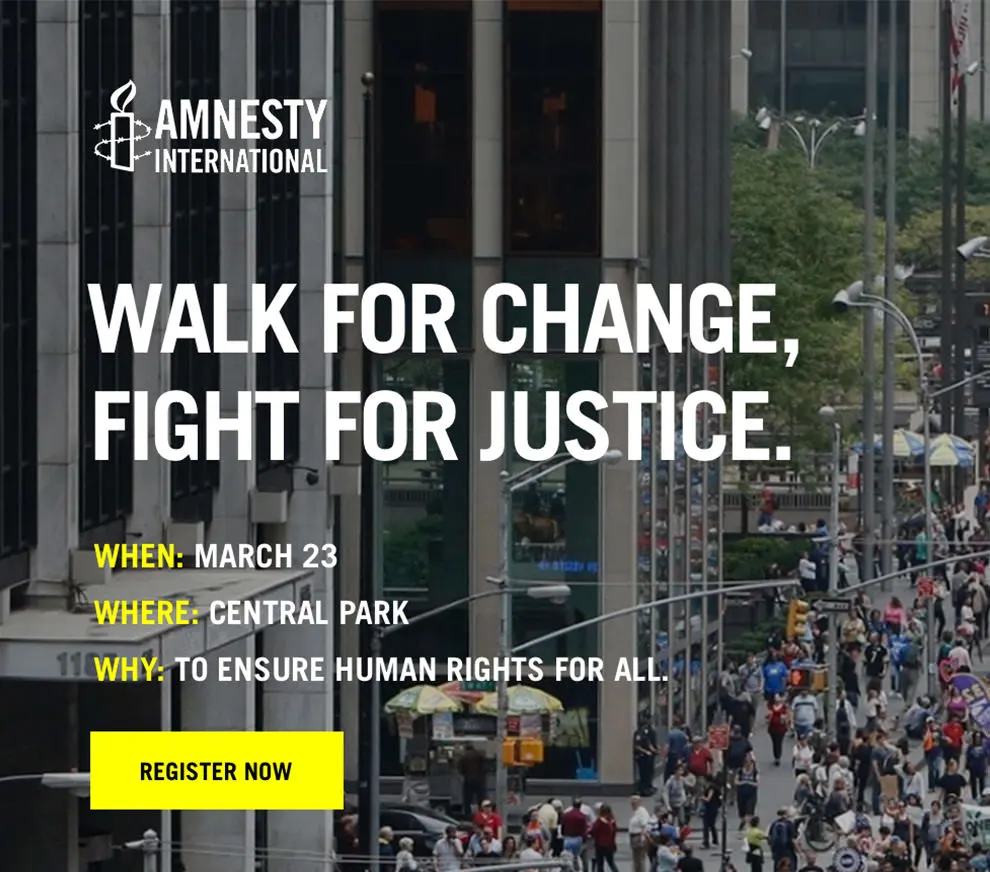
source: Campaign Monitor
Use this type of email to announce, describe, and promote a particular fundraising event to your subscribers. Keep in mind that your message should be brief yet descriptive enough to convey the purpose and value of your potential fundraisers.

-
Donors
Provide them with information such as when, where, ticket prices, and other event details. Also, make sure to add a call-to-action button that will take the recipients to a landing page where they will be able to buy tickets and share information about the event with others.
-
Sponsors
In this email, you need to explain to sponsors how they can sponsor the event, buy table space, and purchase advertising space on event materials.
-
Partners
When creating an event invitation email for your partners, keep in mind that you should provide them with even more details about the event than you provided to sponsors. This will help them determine what they can do for you and what resources they can provide.
-
Volunteers
If you need extra hands at the event, ask past volunteers for help.
“Thank you” email. The key purpose of a “Thank You” emails
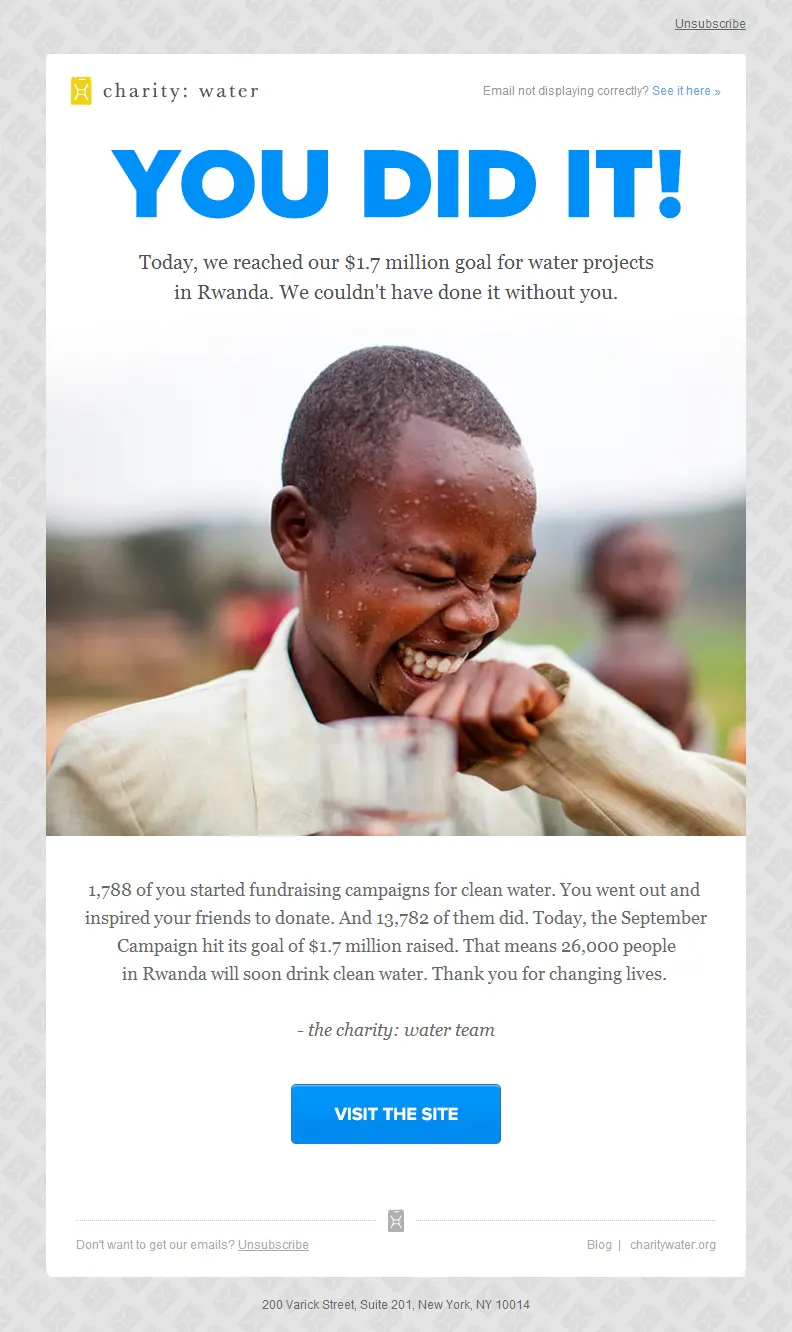
source: Know How
This type of email is an excellent opportunity to show your gratitude to the people who did something for your organization. When a donor feels remembered and that their donations made an impact, they are more likely to donate again. That is why it is essential for you to set up an automatic thank you email for whenever a subscriber fills out a form, donates, etc.
-
Supporters
Always take the time to say thank you not only to donors but also to those who signed up for your updates, submitted a form, spread a word about your organization, etc. Be generous with your thanks.
-
Sponsors
Special thanks should go to business owners for your cause and events sponsorship. In this email, you can also provide additional information about new sponsorship opportunities.
-
Donors
Send a “Thank You” message to all of your donors to appreciate their gift and start building relationships with them.
-
Volunteers
Thank them for their commitment to your cause. You can mention the event where their help will be needed.
General newsletters. Key purpose of general emails

source: Pinterest
Your general newsletters should contain content that would be interesting and relevant to everyone on your list. For example, you may want to let people know what's new at your organization, add your wish list, links to your blog, upcoming events, various success stories, and more.

Newsletters and updates for your team. Key purpose of an internal email
Many nonprofits practice sending updates and newsletters to their employees and volunteers to keep them informed about all the important projects, events, job openings, and opportunities.
How to segment internal newsletter? For this email, you can take Internal team and volunteers together because they both might be interested in what’s happening at your organization.
Donation email. The key purpose of a donation email
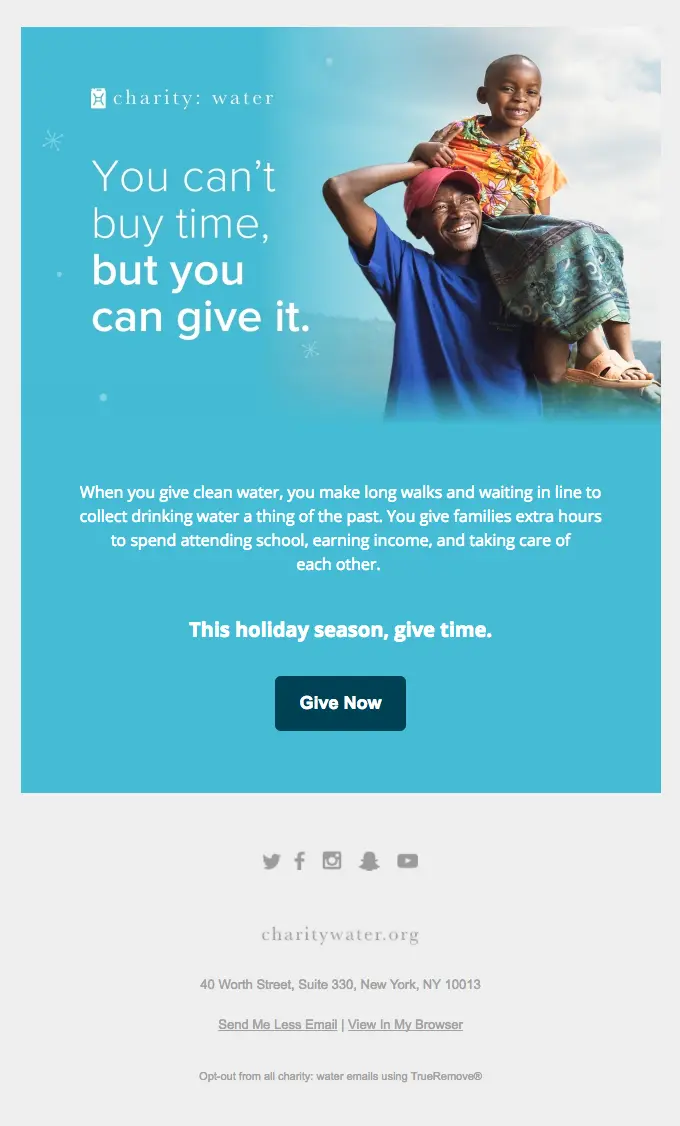
source: Emma
Depending on the donor type you are going to contact, there are various ways you can go about requesting donations.

-
Public supporters (potential donors)
Instead of just focusing on money, try to explain your public supporters what goals you are planning to achieve with their help, share stories of people you helped in the past, make them understand that their money will be used responsibly.
-
Partners
Businesses usually have something to offer when it comes to fundraising. However, if you ask them for donations, you need to offer something in return (e.g., you can place their company name and logos on banners at charity events; you can mention them in your annual report, and more.)
-
Donors
Send this email to your past donors with information about your overall fundraising goal and a clear call-to-action for donations. Focus on their huge value for your organization.
Survey. The key purpose of a survey

source: Copper
By conducting surveys, you can improve how you run your nonprofit organization and communicate with your supporters.

-
Public supporters
Poll your supporters to find out who makes up your base. Discover why they support your cause or organization. Ask on what issues they would like your nonprofit to focus.
-
Current sponsors
Get to know your sponsors by asking questions like “Have they allowed their name to appear on the fundraising pages to which they have donated?”, “What other ways apart of giving money that they have given back in the last years (gave goods to charity, volunteered for charity, gave things to the needy, worked for a religious organization, etc.)?”
-
Donors
You might want to know if it was easy to donate to your group, how well donors understand how their donations will be used, and how likely would they be to donate to your organization again.
-
Objects of representation
To make sure that those who are helped by your organization will get exactly what they need, ask them to take the survey.
Conclusion
Nonprofit email marketing is an excellent way to expand the sphere of influence of your organization. However, even your best nonprofit newsletters would be useless if sent to the wrong audience. Whether you found a free charity donor's email list or built it yourself, you need to segment your subscribers into different groups for more efficient communication. Provide your donors, volunteers, sponsors, partners, public supporters, staff members, and other people who are dealing with your organization only with personalized, relevant content.



